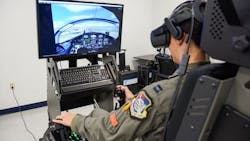Pilot flight training is typically passed along from experienced instructors to trainees. But when a shortage of flight instructors makes it difficult to line up a living trainee, training software can help. Software training tools such as the Joint Immersive Training System (JTS), may not replace human instructors, but they can augment existing training tools and help put more pilots in the air. Developed by Vertex, Inc., the cost-effective software runs on standard desktop and laptop computers, using a combination of artificial intelligence (AI), machine learning (ML), and virtual reality (VR) to train student pilots the art of flight instruction (see figure).
By using portable laptop computers, students can fly at their own pace, adding a USB-connected command center with joystick to simulate aircraft controls. The cost of the computer and software is a fraction of the cost of a traditional aircraft simulation system. Different versions of the software provide more or less complexity, from a simple version for the laptop computer to a more advanced version with a specialized gaming chair and controls that mimic an aircraft cockpit. The software can be used with or without an instructor for guidance. Instructors can also monitor several computer simulators from a distance when necessary.
In addition to Vertex, several companies are working as partners on the flight simulation software. For example, Google is providing cloud infrastructure and cybersecurity to protect the large amount of data that will be carries in “the cloud;” CAE, Inc. is building a learning management system to help students train and to manage the overall training process; and Discovery Machine, Inc. is building an AI-based structure to assist human instructors in monitoring and instructing students. The goal for the JTS is to provide training for all types of fixed- and rotary-wing aircraft, including training for the control of remotely piloted aircraft.
About the Author
Jack Browne
Technical Contributor
Jack Browne, Technical Contributor, has worked in technical publishing for over 30 years. He managed the content and production of three technical journals while at the American Institute of Physics, including Medical Physics and the Journal of Vacuum Science & Technology. He has been a Publisher and Editor for Penton Media, started the firm’s Wireless Symposium & Exhibition trade show in 1993, and currently serves as Technical Contributor for that company's Microwaves & RF magazine. Browne, who holds a BS in Mathematics from City College of New York and BA degrees in English and Philosophy from Fordham University, is a member of the IEEE.
